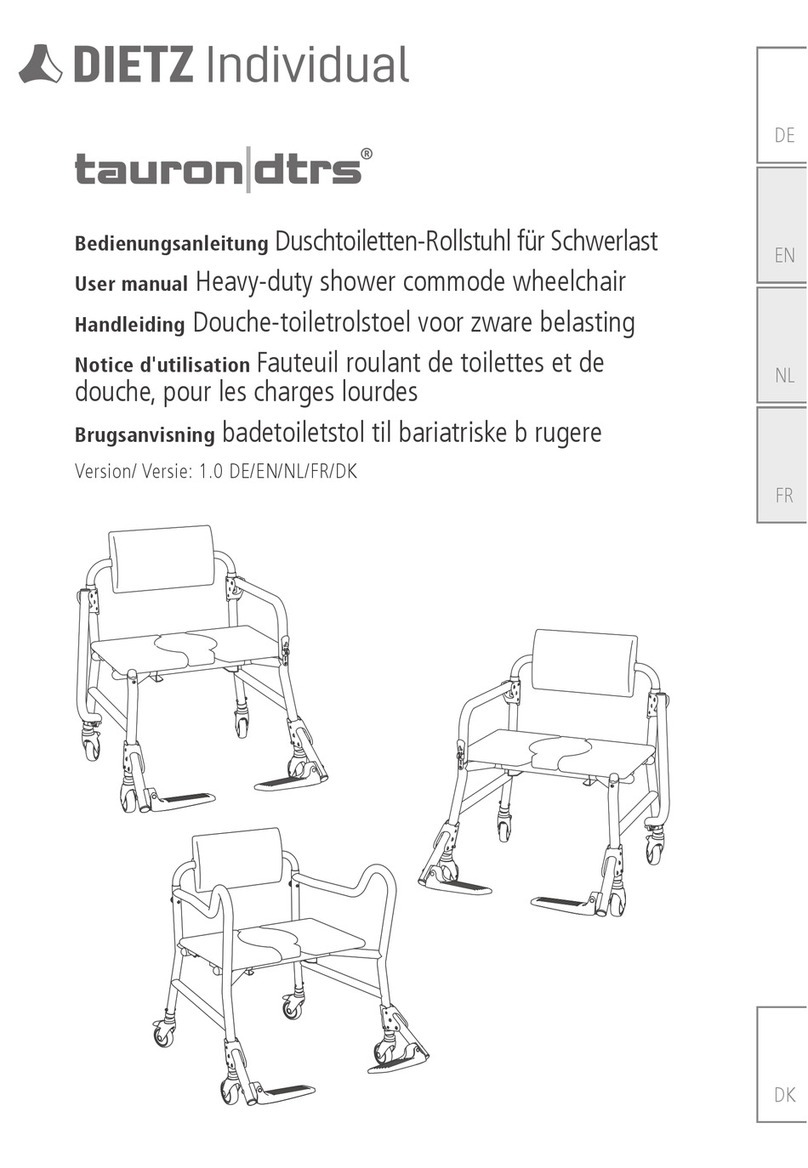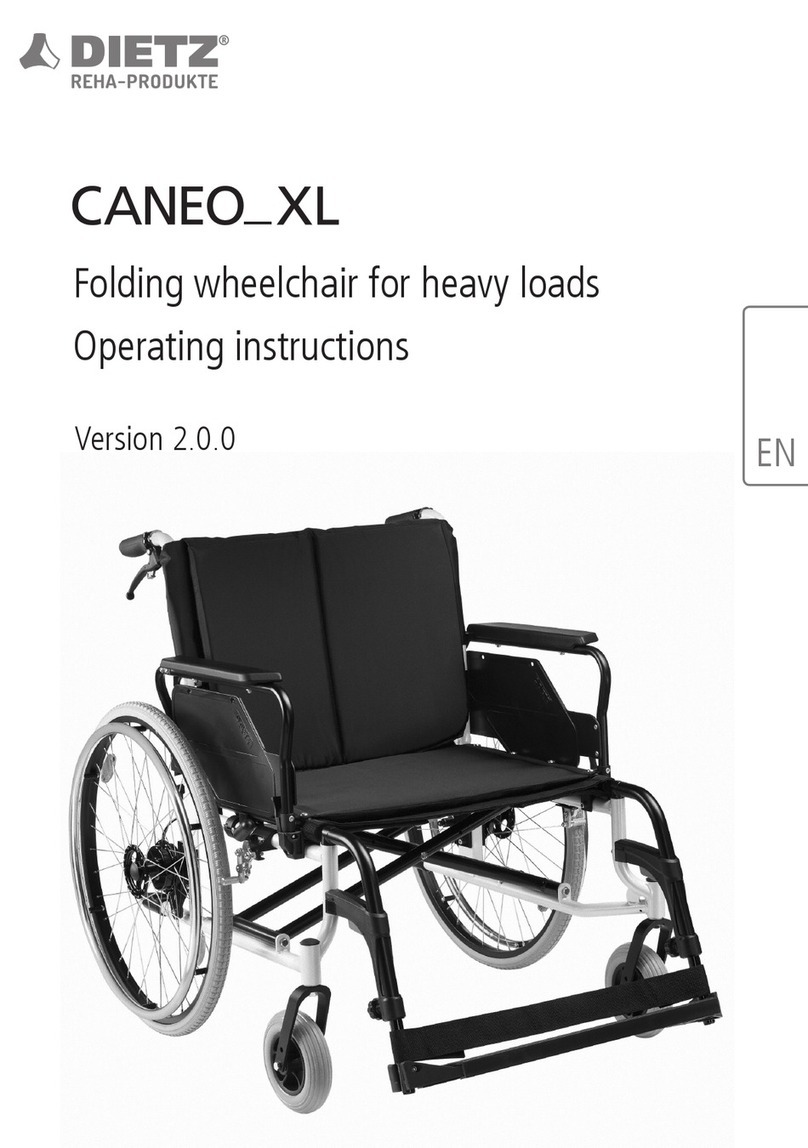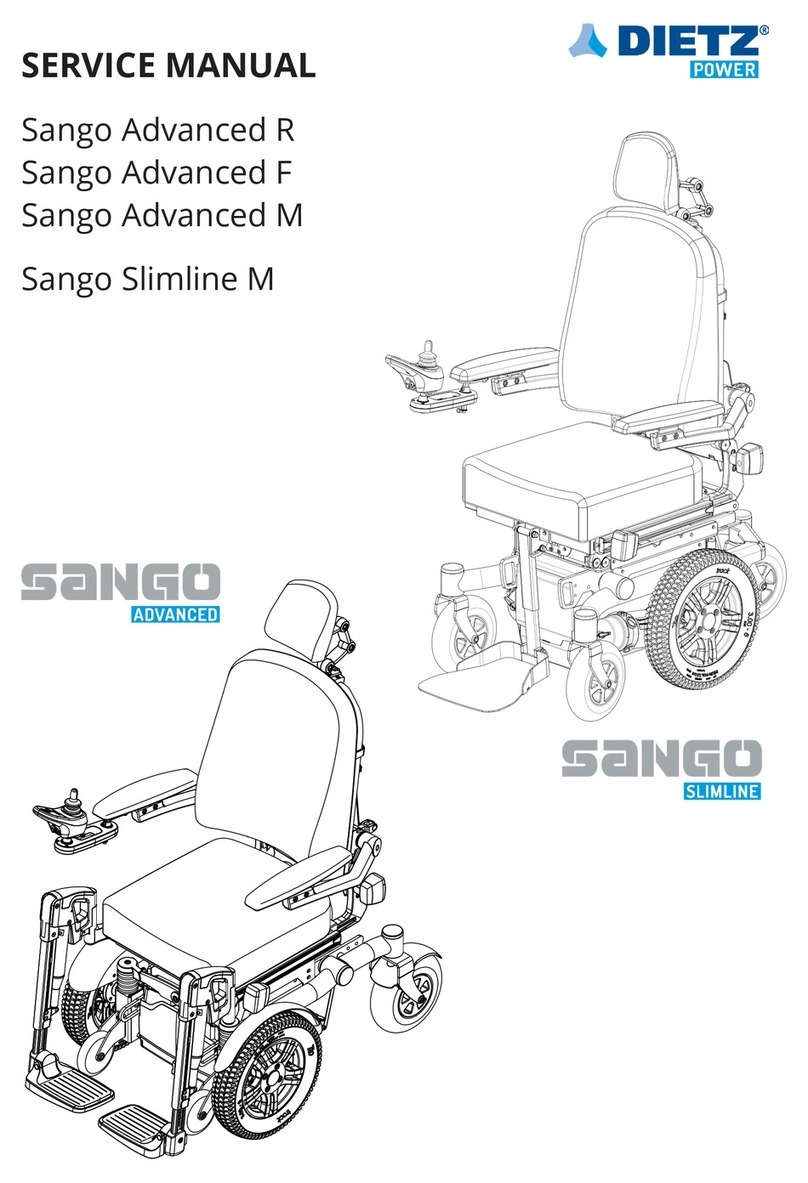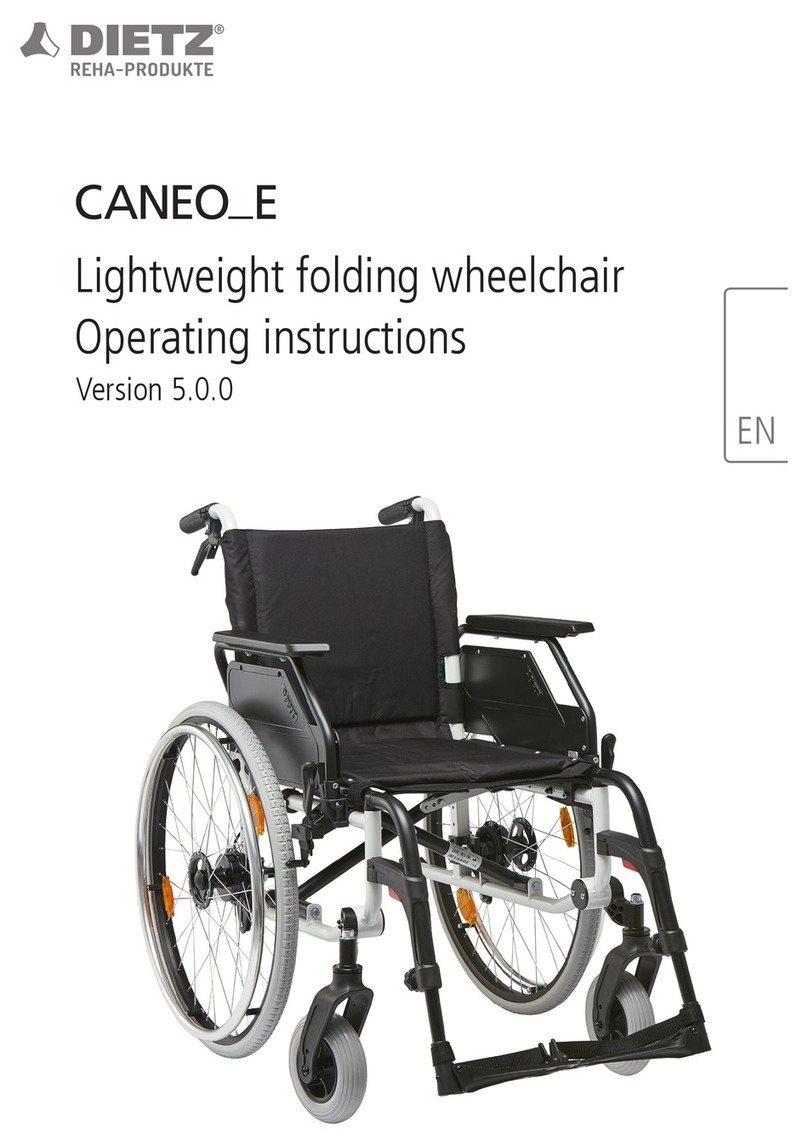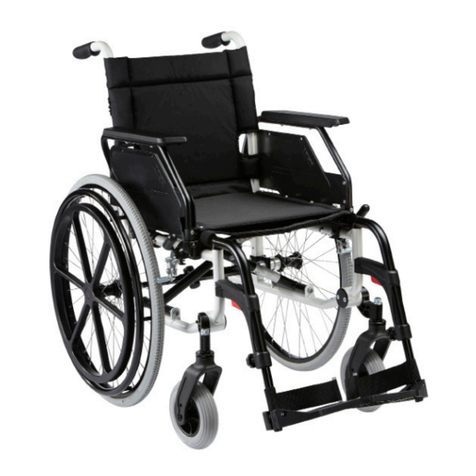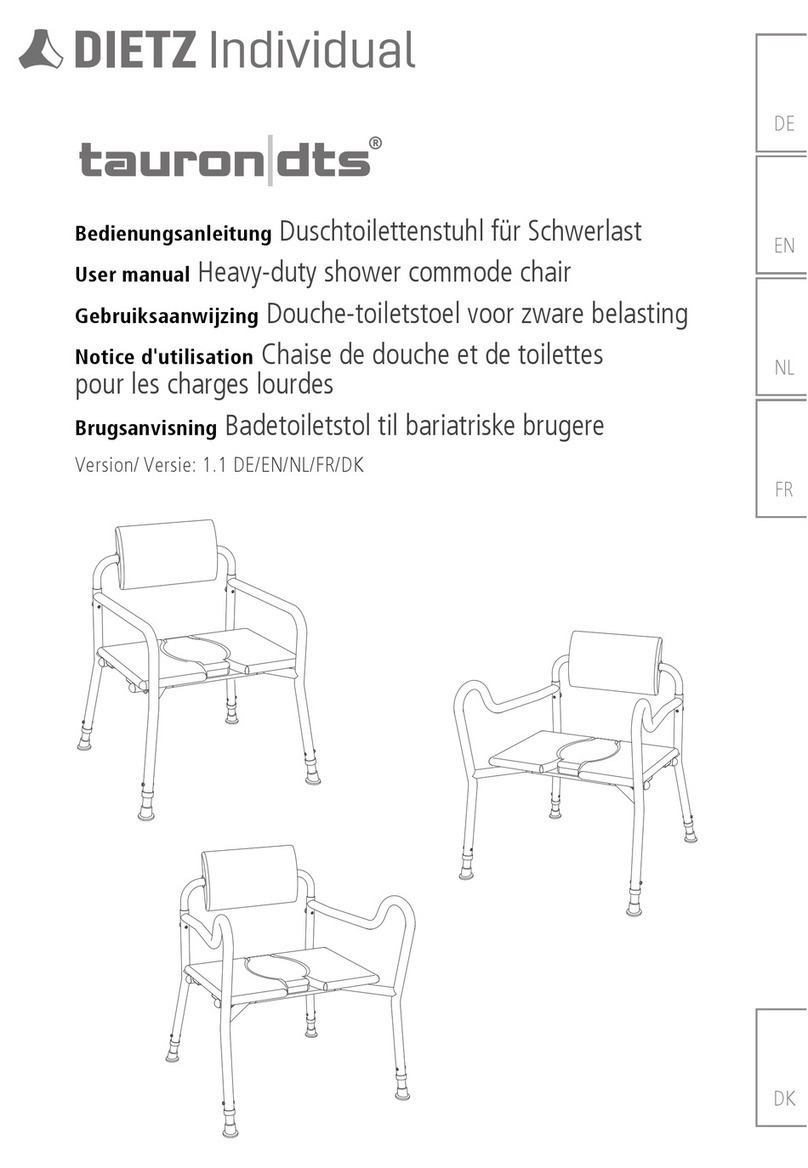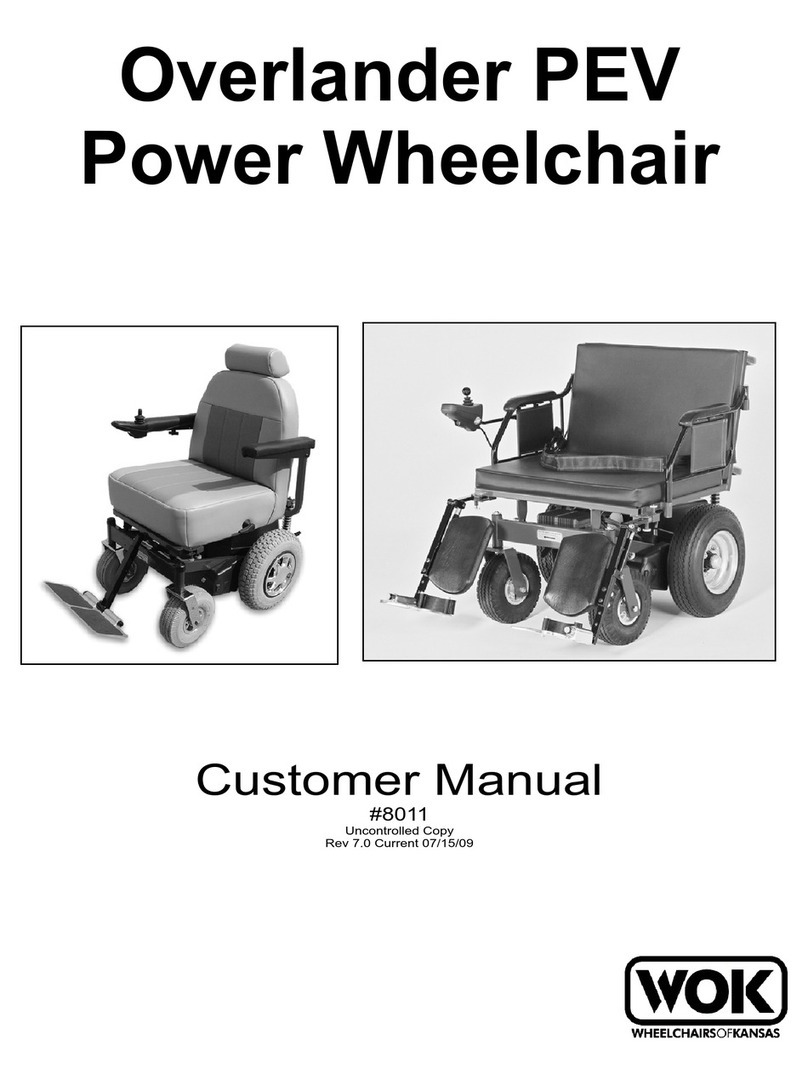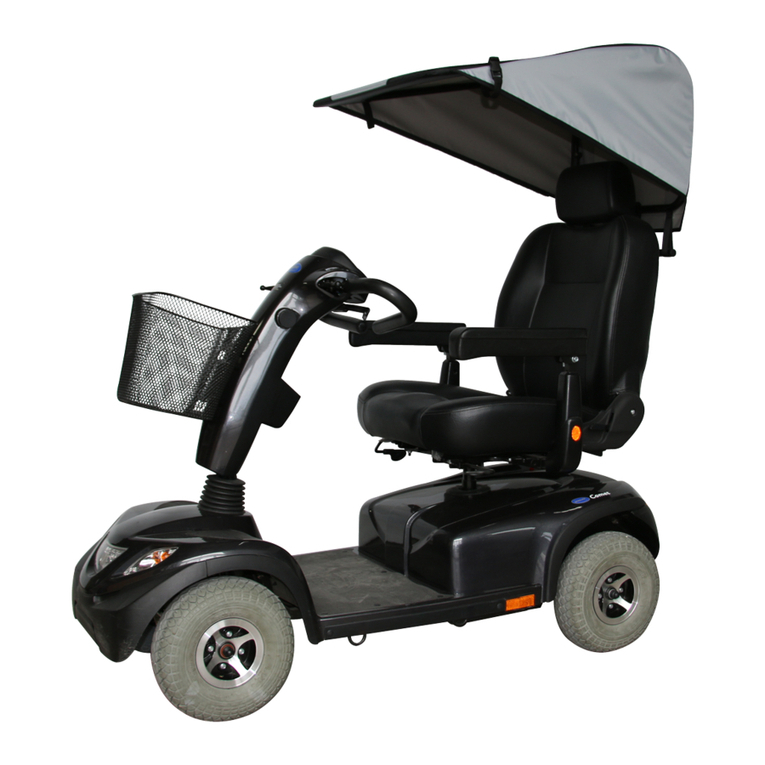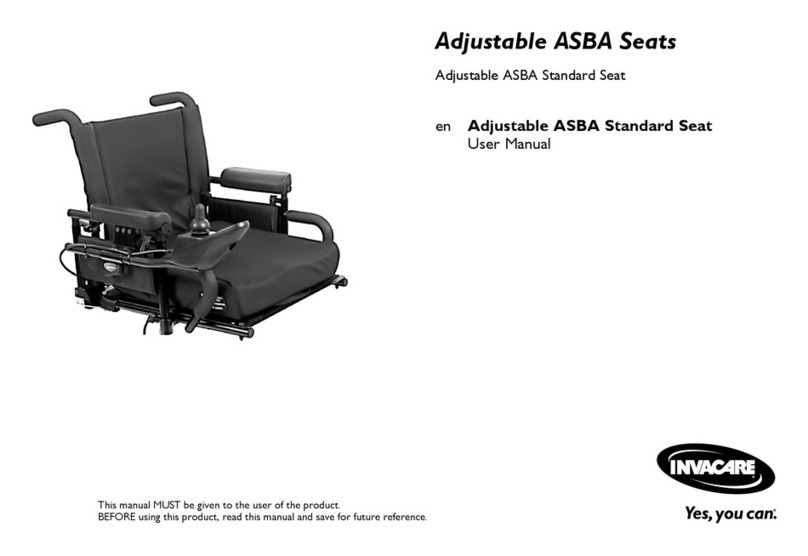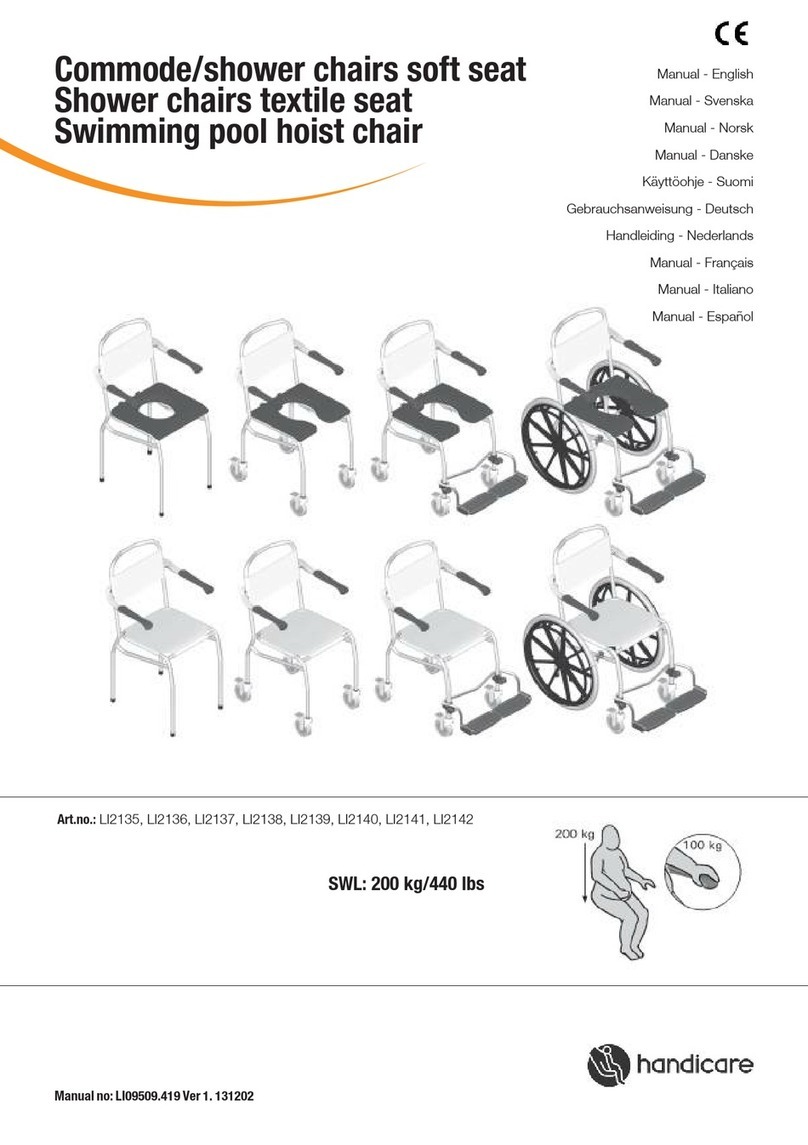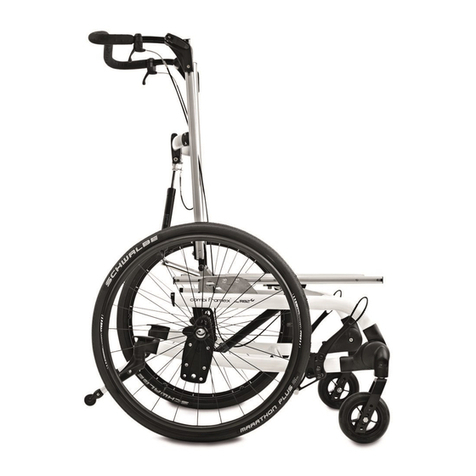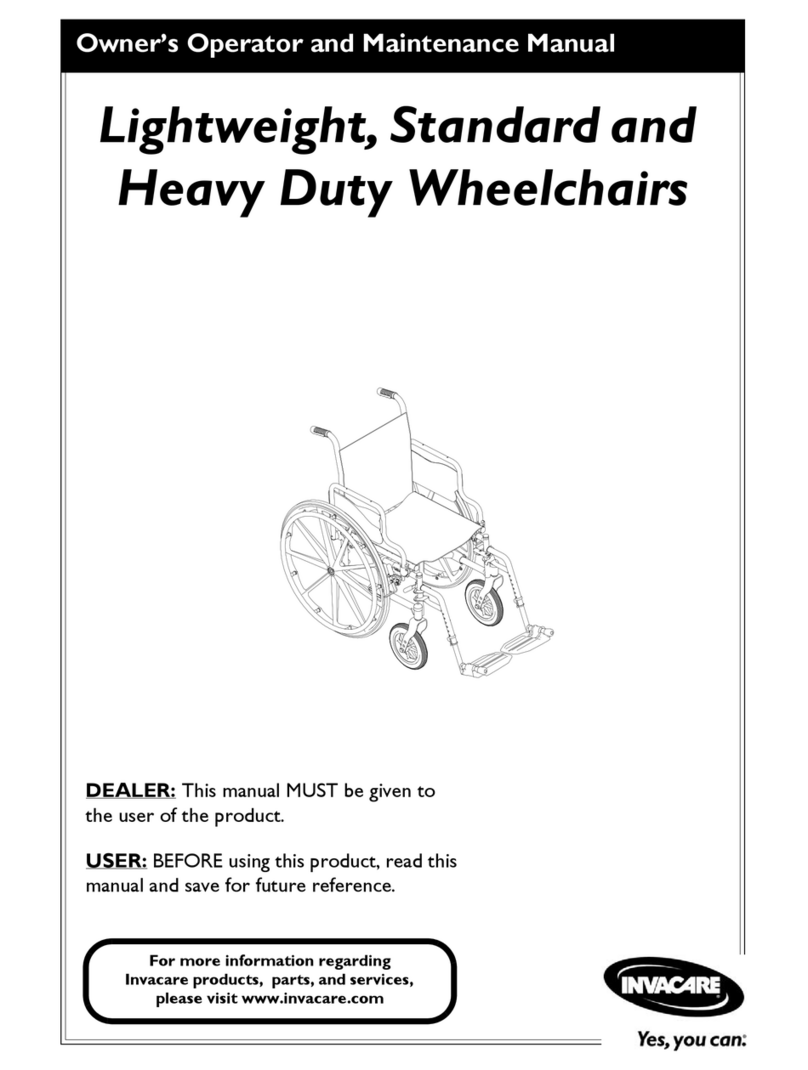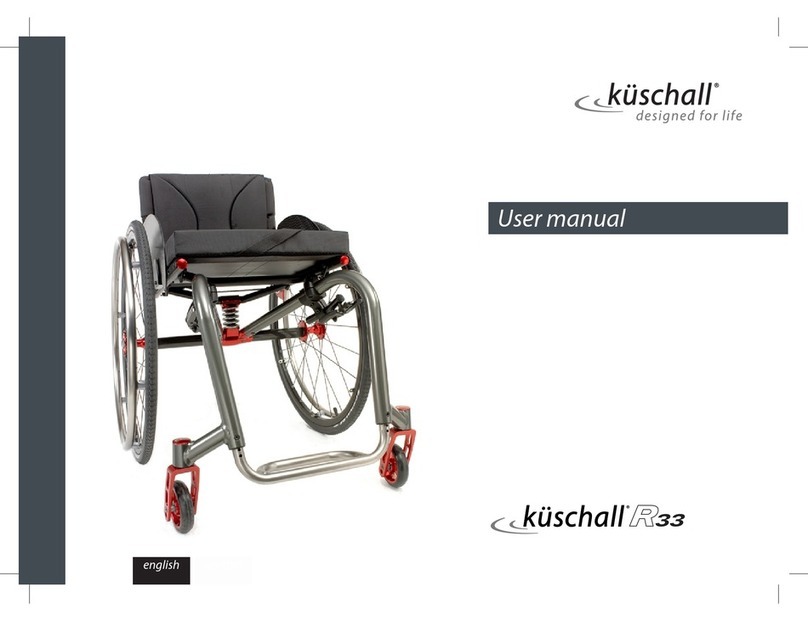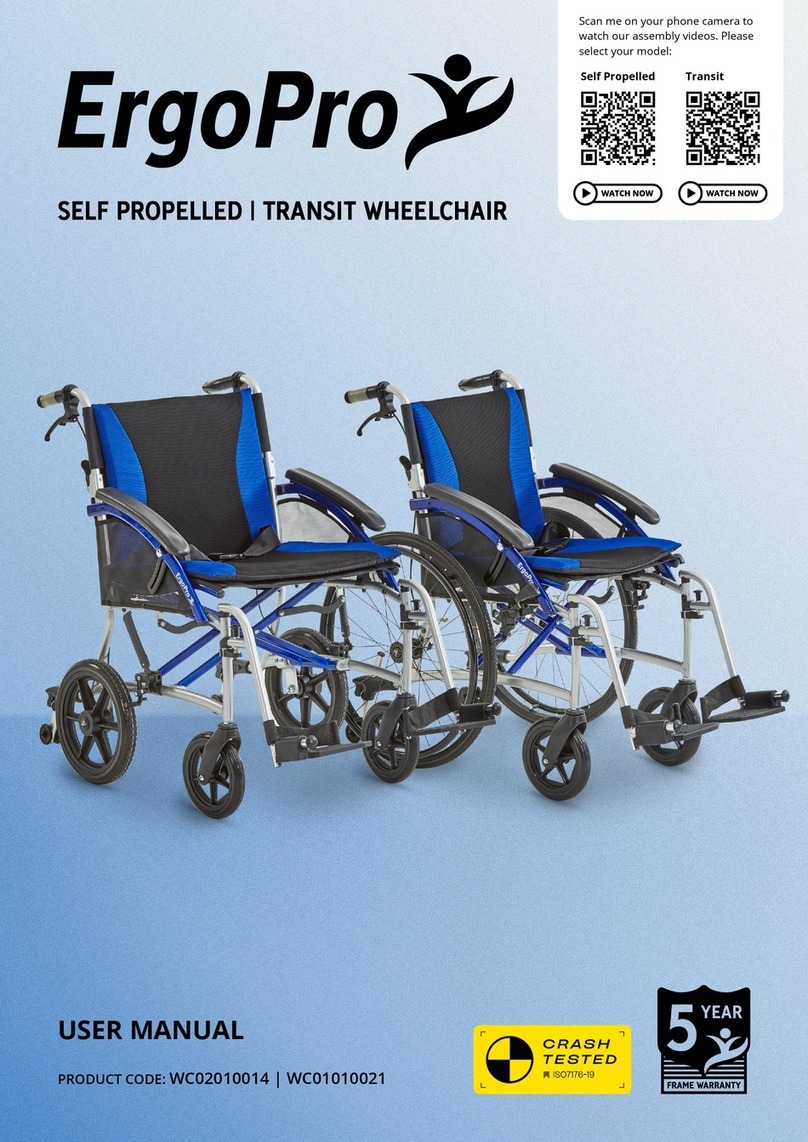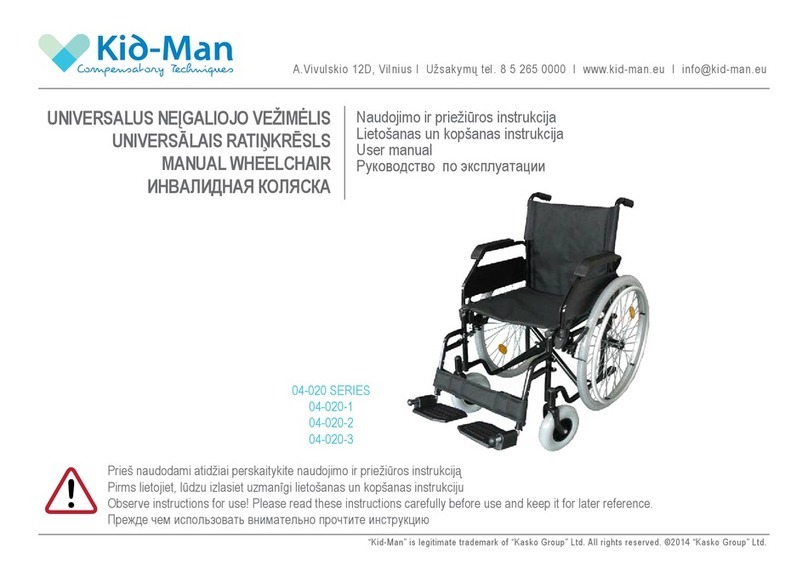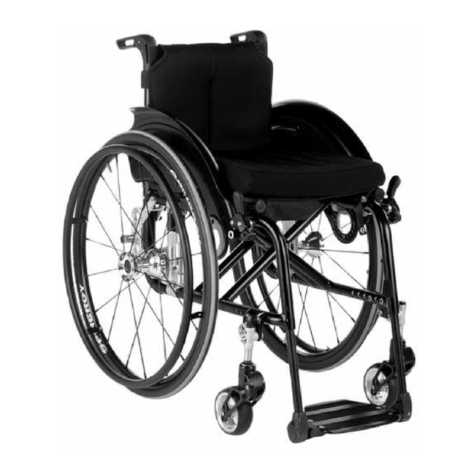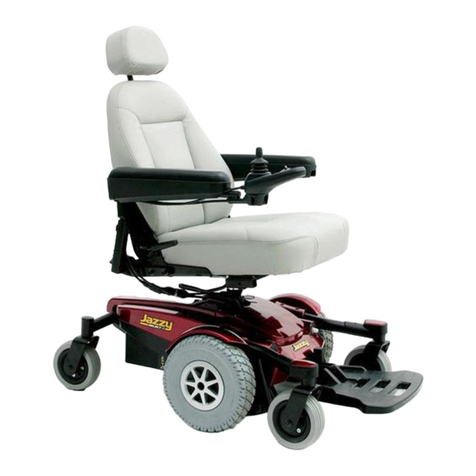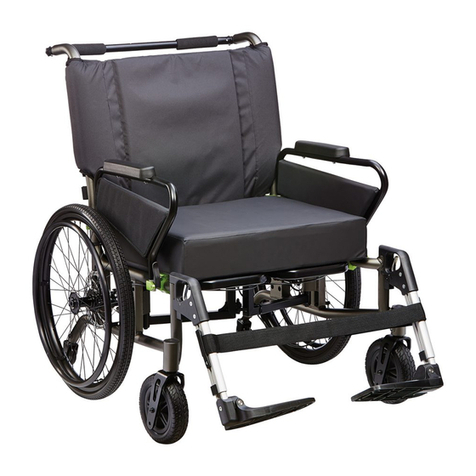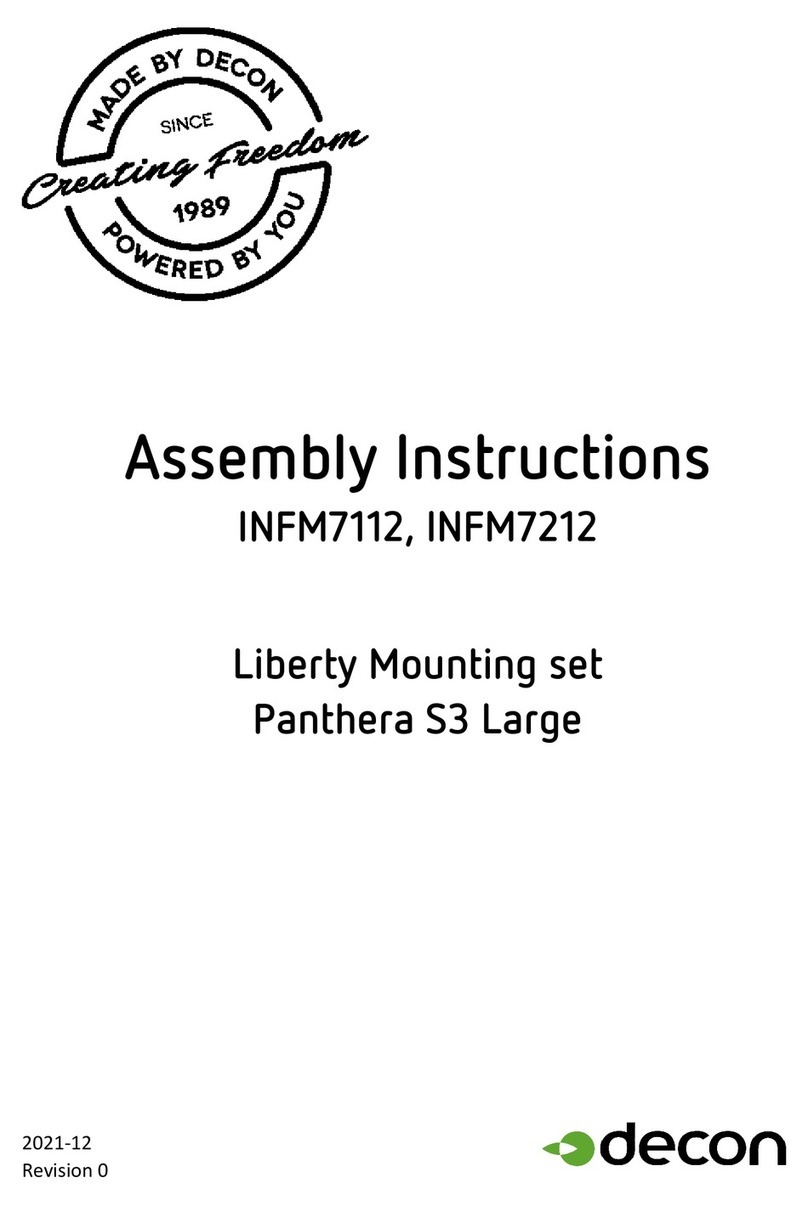Dietz CANEO B User manual

Standard wheelchair
Operating instructions
Version 2.0.1. EN

Product group: Manual wheelchair
Product: Standard wheelchair
User’s manual Version 2.0.1. EN
State 11/2015 (LA/RP)
DIETZ GmbH
Reutäckerstraße 12
76307 Karlsbad
Tel.: +49 7248.9186-0
Fax: +49 7248.9186-86
www.dietz-reha.de
Pictures and Illustrations in this user manual
may differ from the actual product.
Thank you for purchasing a CANEO_B
wheelchair from DIETZ Reha Produkte.
Please read these operating instructions carefully before rst using the wheel-
chair.They contain important safety instructions and valuable tips on correctly
using and caring for the wheelchair. If you have any questions or require addi-
tional information, please contact the specialist retailer which supplied the
wheelchair to you.
These operating instructions contain all of the instructions necessary for ad-
justing and operating the CANEO_B wheelchair. The CANEO_B is character-
ised by its high stability and diverse setting options.
2 3
DIETZ GmbH / Operating instructions standard wheelchair CANEO_B / Version 2.0.1. EN
OPERATING INSTRUCTIONS CANEO_B

4 5
DIETZ GmbH / Operating instructions standard wheelchair CANEO_B / Version 2.0.1. EN
CONTENTS
01 Information
Intended purpose . . . . . . . . . . . . . . . . . . . . . .6
Indication . . . . . . . . . . . . . . . . . . . . . . . . . . . .6
Contraindication . . . . . . . . . . . . . . . . . . . . . . .6
Warning symbols. . . . . . . . . . . . . . . . . . . . . . .7
02 Product description
Scope of delivery. . . . . . . . . . . . . . . . . . . . . . .8
The CANEO_B‘s equipment . . . . . . . . . . . . . . .9
03 Putting into operation
Preparing the wheelchair for use . . . . . . . . . .11
3.1 Folding apart . . . . . . . . . . . . . . . . . . . .12
3.2 Back upholstery . . . . . . . . . . . . . . . . . .13
3.3 Leg rests . . . . . . . . . . . . . . . . . . . . . . .13
3.4 Foot plates . . . . . . . . . . . . . . . . . . . . . .14
3.5 Removing and connecting
the rear wheels . . . . . . . . . . . . . . . . . .15
3.6 Seat depth . . . . . . . . . . . . . . . . . . . . . .16
3.7 Lower leg length. . . . . . . . . . . . . . . . . .17
04 Drive mode
4.1 Getting in and out of your wheelchair . .18
4.2 Swivelling the side panels back . . . . . .20
4.3 Folding up the foot plates . . . . . . . . . .20
4.4 Swivelling away and detaching
the leg rests . . . . . . . . . . . . . . . . . . . . .21
4.5 Propelling and slowing down the
wheelchair with the push rims. . . . . . . .22
4.6 Locking brakes . . . . . . . . . . . . . . . . . . .23
4.7 Braking by an accompanying
person (optional) . . . . . . . . . . . . . . . . .24
4.8 Anti-tip wheels (optional) . . . . . . . . . . .25
4.9 Tilting aids . . . . . . . . . . . . . . . . . . . . . .25
4.10 Transporting and folding together . . . . .26
4.11 Safety belt (optional). . . . . . . . . . . . . . .27
05 Adjustments for individual settings
Important note about the adjustments . . . . .28
5.1 Locking brakes . . . . . . . . . . . . . . . . . . .28
5.2 Drum brakes (optional) . . . . . . . . . . . . .29
5.3 Armrests. . . . . . . . . . . . . . . . . . . . . . . .29
5.4 Seat height adjustment . . . . . . . . . . . .30
5.5 Extending the wheelbase . . . . . . . . . . .31
06 Technical data
Dietz‘s measurement system . . . . . . . . . . . . .32
Dimensions and weight . . . . . . . . . . . . . . . .34
Maintenance log . . . . . . . . . . . . . . . . . . . . . .35
07 General safety instructions
Safety instructions. . . . . . . . . . . . . . . . . . . . .36
CONTENTS
08 Instructions for general use
Checking the wheelchair by the user . . . . . . .38
Care instructions for the user. . . . . . . . . . . . .39
Labels. . . . . . . . . . . . . . . . . . . . . . . . . . . . . .39
Serial number . . . . . . . . . . . . . . . . . . . . . . . .39
Disposal . . . . . . . . . . . . . . . . . . . . . . . . . . . .39
Forwarding/reusing . . . . . . . . . . . . . . . . . . . .40
09 Guarantee
Warranty. . . . . . . . . . . . . . . . . . . . . . . . . . . .41
Declaration of conformity . . . . . . . . . . . . . . .41
Responsibility . . . . . . . . . . . . . . . . . . . . . . . .41
Liability. . . . . . . . . . . . . . . . . . . . . . . . . . . . .41
10 INDEX
Index . . . . . . . . . . . . . . . . . . . . . . . . . . . . . .42

CAUTION
Warnings about potential
dangers with the risk of injury of
the user or accompanying person.
NOTE
Valuable tips and tricks to help
you use your wheelchair.
ATTENTION
Warning about potential dangers
that might damage or destroy the
product.
6 7
DIETZ GmbH / Operating instructions standard wheelchair CANEO_B / Version 2.0.1. EN
01 INFORMATION
INTENDED PURPOSE
The CANEO_B wheelchair has been designed for indoor and outdoor
use. It can be self-propelled by the patient or used with an accompany-
ing person to support.
In two variants, the CANEO_B is designed for a maximum load of 130 kg
or 140 kg. This specification can be checked on the serial number sticker
placed on the crossbar/frame.
INDICATION
Inability to walk or severely pronounced walking disability due to
wParalysis
wLoss of limbs
wLimb defect/deformation
wJoint contracture/joint damage (not on both arms)
wOther diseases
CONTRAINDICATION
Use of the wheelchair is unsuitable in the case of
t False sensations
t Severe disequilibrium
t Loss of limbs on both arms
t Joint contracture/joint damage on both arms
t Inability to sit
t Impaired or inadequate vision
01 INFORMATION
SYMBOLS
Different symbols are used in this manual to give
you warnings about potential dangers and help-
ful advice for the daily use of your wheelchair.

8 9
DIETZ GmbH / Operating instructions standard wheelchair CANEO_B / Version 2.0.1. EN
02 PRODUCT DESCRIPTION
The CANEO_B wheelchair is packed in a cardboard box. Please keep the
packaging if possible; it can subsequently be used to store the wheel-
chair if necessary.
The CANEO_B is pre-assembled and very easy to set up. To get started
you simply have to unfold the wheelchair and click the leg rests into
place. In the following chapter you can find some information about
how to set up and use your wheelchair.
In chapter »03 Putting into operation« from page 11 you can find
information about simple settings and adjustments that can be done
without tools.
In chapter »05 Adjustments for individual settings« from page 28
you can find information about more complex settings to adjust the
wheelchair to your special requirements. Some of these adjustments
may only be carried out by trained service personnel.
SCOPE OF DELIVERY
On receipt of the wheelchair, please immediately check to make sure
that the contents are complete and undamaged.The contents consist of:
w1 set of cardboard box and packaging
w1 pre-assembled wheelchair
w1 pair of leg rests
w1 user’s manual
wEquipment (if selected)
02 PRODUCT DESCRIPTION
Locking brake Foot plate
Heel strap
Quick-release axle
Leg rest
Side panel
Armrest
BackrestPush handles
Push rims
Curb climber
THE CANEO B’S EQUIPMENT
Basic components

10 11
DIETZ GmbH / Operating instructions standard wheelchair CANEO_B / Version 2.0.1. EN
03 PUTTING INTO OPERATION
PREPARING THE WHEELCHAIR FOR USE
The CANEO_B is pre-assembled and very easy to set up. To get started
you simply have to unfold the wheelchair and click the leg rests into
place. In this folowing chapter you can find some information about
how to set up and use your wheelchair. You can find information about
simple settings and adjustments that can be done without any tools.
Information about more complex adjustments like seat height etc. can
be found in chapter »05 Adjustments for individual settings«
from page 28.
CAUTION
Risk of trapping!
When folding and unfolding your wheelchair, pay attention
to your ngers and only grip the parts as seen in the
illustrations.

12 13
DIETZ GmbH / Operating instructions standard wheelchair CANEO_B / Version 2.0.1. EN
03 PUTTING INTO OPERATION
3.1 Folding apart
Position yourself next to the wheelchair and
tilt it slightly towards you. Then press the
crossbar apart with both your hands.
Make sure that the crossbar engages properly
in its sideframe brackets.
03 PUTTING INTO OPERATION
3.2 Back upholstery
Pull the backupholstery lid to the rear under-
side of the seat and secure it with the Velcro
strap; the gap between the backrest and the
seat surface is now closed.
3.3 Leg rests
Hook the leg supports in and swivel them for-
wards. The leg rest will then click into place
automatically.

14 15
DIETZ GmbH / Operating instructions standard wheelchair CANEO_B / Version 2.0.1. EN
3.4 Foot plates
Fold the foot plates down.
03 PUTTING INTO OPERATION
3.5 Removing and connecting the rear
wheels
In some situations it is helpful to remove the
rear wheels.
Press the button on the quick-release axle and
hold the hub with four fingers. Then pull the
rear wheel out of the axle mounting.
To connect the rear wheels, press the quick-re-
lease axle button with your thumb again. Now
insert the axle into the axle mounting; the
quick-release axle will engage automatically.
NOTE
Push the quick-release button
while engaging the wheels. The
axle/wheel will engage a lot
easier.
ATTENTION
After connecting the wheels
make sure that the quick-release
axles are engaged properly.
03 PUTTING INTO OPERATION

16 17
DIETZ GmbH / Operating instructions standard wheelchair CANEO_B / Version 2.0.1. EN
3.6 Seat depth
The wheelchair is always delivered with the
maximum possible seat depth. To reduce the
seat depth, first remove the leg supports. Next,
open the Velcro straps on the right and left of
the seat frame. Secure the Velcro straps to the
extension so that they are no longer wrapped
around the frame. Fold the extension beneath
the seat and fasten the Velcro straps to secure
it there.
Carry the procedure out in the opposite se-
quence to increase the seat depth.
03 PUTTING INTO OPERATION 03 PUTTING INTO OPERATION
3.7 Lower leg length
The setting is correct when your upper legs are
horizontal with your feet positioned on the
foot plates.
To adjust, release the adjustment screw one
quarter of a turn and pull the locking mecha-
nism backwards. Move the foot plate to a
comfortable position and release the locking
mechanism again. The mechanism automati-
cally locks in the next position. Then tighten
the adjustment screw securely again.

18 19
DIETZ GmbH / Operating instructions standard wheelchair CANEO_B / Version 2.0.1. EN
04 DRIVE MODE
DRIVE MODE
4.1 Getting in and out of your
wheelchair
Different handicaps allow more or less ma-
noeuvrability.
To get in and out of your wheelchair easily and
safely, the following tips can be helpful.
NOTE
To stop the wheelchair from rolling
or sliding away while getting
seated, it is helpful to place both
rear wheels against a wall.
04 DRIVE MODE
Getting into your wheelchair
1. Take off the leg rests (see chapter 4.4).
2. If possible, place the wheelchair’s rear wheels against a wall to
avoid any roll-off.
3. Apply both locking brakes.
4. Place yourself in front of the wheelchair. Then carefully move back-
wards until your legs touch the seat.
5. Now grab the armrest with your hands.
6. You can now sit down slowly and safely.
7. Put the leg rests back into place.
8. Fold the foot plates down (see chapter 3.4).
Getting out of your wheelchair
Carry the procedure out in the opposite sequence.
NOTE
To transfer sidewards, you can swing away the side panels
(Chapter 4.2, page 20).

20 21
DIETZ GmbH / Operating instructions standard wheelchair CANEO_B / Version 2.0.1. EN
4.2 Swivelling the side panels back
To swivel up, press the locking lever and pull
the side panel upwards.
The side panel engages automatically on swiv-
elling back.
This engagement is clearly audible.
4.3 Folding the foot plates up
Fold the foot plates up to make entering and
exiting easier.
The foot plates must be folded up to save
space when folding the wheelchair together.
04 DRIVE MODE
4.4 Swivelling away and detaching the
leg rests
To remove the leg rests, first fold the foot
plates up.
Now pull the locking lever (orange) and swivel
the leg support outwards.
The leg support can now be detached up-
wards.
Carry the procedure out in the opposite se-
quence during assembly.
When the leg support is swivelled forwards, it
can be clearly heard to engage.
04 DRIVE MODE

CAUTION
When propelling your wheelchair,
make sure that you do not touch
the tyre casing with your thumb.
Risk of trapping between the tyre
and side panel/armrest!
22 23
DIETZ GmbH / Operating instructions standard wheelchair CANEO_B / Version 2.0.1. EN
4.5 Propelling and slowing down the
wheelchair with the push rims
The wheelchair can be manoeuvred forwards,
rearwards and left to right by using the push
rims on the rear wheels.
Hold the push rim with your hand and move
the wheel to the front or rear.
Your thumb should lay on top while you grab
the push rim by making a fist.
To slow down the wheelchair, control the push
rim by letting it slide through your hand.
CAUTION
During hard braking manoeuvres
the pushrims can become quite
hot.
04 DRIVE MODE
4.6 Locking brake
The locking brake enables the user to park the
wheelchair securely.
Actuate the locking brake (tyre brake) when
stationary. To do this, push the lever forwards
until it stops independently. The wheelchair is
now standing securely; you can now transfer
or simply park.The locking brake is released by
pulling the lever backwards.
NOTE
Always apply both brakes together
to avoid any movement of the
wheelchair
While moving always slow down the wheel-
chair by using the push rims. The locking
brakes are only used for parking and can not
control the wheelchair at speed.
04 DRIVE MODE

24 25
DIETZ GmbH / Operating instructions standard wheelchair CANEO_B / Version 2.0.1. EN
4.7 Braking by an accompanying
person (optional)
While moving, slow down the wheelchair by
pulling both levers upwards. To park the chair
you can lock the brake levers. To do this, pull
up the lever and subsequently pull up the
small locking lever.
The locking lever will then engage automati-
cally.To release the brake simply pull the brake
lever upwards and the locking lever will re-
lease automatically.
The accompanying person can use the option-
al drum brake as a service and locking brake.
This is particularly advantageous when moving
on slopes. Movement can then be reduced by
applying the brake levers more or less strongly
as required. In addition, the drum brake can
also be used as a parking brake.
NOTE
Always use the left and right
brake simultaneously. Using only
one side will make the chair very
hard to manoeuvre.
CAUTION
In models without an optional
drum brake, the accompanying
person must be physically and
mentally able to stop the
wheelchair busing his own
strength. The locking brake is
then available as a parking brake.
04 DRIVE MODE
4.8 Anti-tip wheels (optional)
The optional anti-tip wheels prevent the
wheelchair from tipping backwards. They can
also be used to help tilt the chair by an accom-
panying person.
The height of the wheels can be adjusted. To
do this, pull the silver-coloured disks towards
you and slide the tube upwards or downwards
along the bracket.
4.9 Tilting aids
The tilting aids enable the accompanying per-
son to tilt the wheelchair and therefore move
it over obstacles more easily. Place your foot
onto the back of the frame tube and maintain
balance using the pushing handle.
Anti-tip supports can be optionally tted in-
stead of the rubber buffers; these can be used
as tilting aids and tipping protection to the rear.
04 DRIVE MODE

26 27
DIETZ GmbH / Operating instructions standard wheelchair CANEO_B / Version 2.0.1. EN
4.10 Transporting and folding together
Your wheelchair can be comfortably folded to-
gether for transportation or simply to save
space. It then takes up very little space and
can be easily stowed.
In addition, the rear wheels can also be easily
removed.
Detach the leg rests if necessary and release the
backrest lid from beneath the seat surface.Then
pull the seat cover up from the centre; the
wheelchair subsequently folds together auto-
matically.
To unfold the wheelchair, refer to the instruc-
tions under »05 Adjustments for individu-
al settings« from page 28.
NOTE
The CANEO_B is tested according
to ISO 7176-19 and can be used
as a seat in a passenger car.
04 DRIVE MODE
4.11 Safety belt (optional)
An optional safety belt can be installed. This
secures and stabilises the person seated in the
wheelchair. Tipping forwards out of the wheel-
chair is prevented.
The safety belt is secured to the backrest tube at
the rear right and left. Subsequent installation
should be carried out in a specialist workshop.
04 DRIVE MODE

28 29
DIETZ GmbH / Operating instructions standard wheelchair CANEO_B / Version 2.0.1. EN
05 ADJUSTMENTS FOR INDIVIDUAL SETTINGS
5.1 Locking brake
The distance between the brake pin and tyre
casing must be 12–14 mm at the narrowest
point when the brake is fully open.
Loosen the bolt to adjust/correct the distance
if necessary. Then push the brakes to the cor-
rect position. Subsequently retighten the bolt
and check the function of the brake.
If the wheelbase is changed (chapter 5.5), it
may be necessary to remove the bolt com-
pletely and install the brake in a recess further
forwards or to the rear.
CAUTION
Brake adjustment should be
carried out by trained specialists.
If you have sufficient experience,
however, you may also carry this
work out yourself.
Incorrectly adjusted brakes may
have life-threatening consequences.
05 ADJUSTMENTS FOR INDIVIDUAL SETTINGS
5.2 Drum brake (optional)
The braking power of the drum brakes can be ad-
justed by adjustment screws. The braking force is
increased by unscrewing the adjustment screw.
CAUTION
Ensure even adjustment on both
sides of the wheelchair.
5.3 Armrests
Loosen the two bolts securing the armrest to
the side panel. The armrests can then be
moved forwards or backwards. Then tighten
the bolts securely again to the side panel.

30 31
DIETZ GmbH / Operating instructions standard wheelchair CANEO_B / Version 2.0.1. EN
5.4 Seat height adjustment
The seat height of the wheelchair seat can be
adjusted in two steps of 3 cm (47 cm and 50 cm).
The front fork has two holes (high/low). Use the
lower hole for 50 cm seat height. Use the upper
hole for 47 cm seat height.
On the rear the seat height is adjusted by mov-
ing the rear wheel adapter plate up or down.
Use the lower hole for 50 cm seat height. Use
the upper hole for 47 cm seat height.
CAUTION
A change in the height of the
seat necessitates readjustment of
the brakes.
05 ADJUSTMENTS FOR INDIVIDUAL SETTINGS
5.5 Extending the wheelbase
Moving the rear wheels backwards increases
the distance between wheels and therefore
also the stability of the wheelchair. Moving the
rear wheels forwards will increase the ma-
noeuvrability of your wheelchair but make the
chair less stable.
To alter the wheelbase first remove the rear
wheels. Then take off the rear wheel adapter
(two bolts M6) Now rotate the adapter by
180° and re-install it. Make sure that the bolts
are tightened securely again.
CAUTION
Altering the wheelbase means
the locking brakes will have to be
readjusted (see chapter 5.1).
CAUTION
Front and rear seat heights must
always be the same.
05 ADJUSTMENTS FOR INDIVIDUAL SETTINGS

32 33
DIETZ GmbH / Operating instructions standard wheelchair CANEO_B / Version 2.0.1. EN
06 TECHNICAL DATA
6. DIETZ’s measurement system
There is no standard procedure to measure up a wheelchair and different manufacturers take their
measurements in different ways.To avoid any mistakes all measurements are clearly defined in the
following pictures. All dimensions provided in this manual are taken according to this system.
Seat depth: Total length of the seat tube front to back
Seat width: Total width from outer edges of the seat tubes left to right
Back height: Total height from seat upholstery to upper edge of back upholstery
Seat depth
Seat width
Back height
06 TECHNICAL DATA
Front seat height: Total height from ground to front upper edge of the seat tube
Rear seat height: Total height from ground to rear upper edge of the seat tube
Lower leg length: Total length from foot plate (centre) to upper edge of the
leg rest acceptance
NOTE
All dimensions taken on textile
parts (e.g. back upholstery) are
to be understood with a toler-
ance of +/–1 cm.
Rear seat height
Lower leg length
Front seat height

34 35
DIETZ GmbH / Operating instructions standard wheelchair CANEO_B / Version 2.0.1. EN
HMV no.
(German medical aids and appliances number) No.
18.50.02.0116 18.50.02.0116
Seat width (cm) 39–45 in steps of 3 cm 48–51 in steps of 3 cm
Seat depth (cm) 40–44 in steps of 4 cm
Seat height front/rear (cm) 48–51
Back height (cm) 40
Armrest height (cm) 23
Overall dimensions (W × H × L) (cm) 59–65 × 90 × 110 68–71 × 90 × 110
Seat angle (degree) 3°
Back angle (degree) 3° with lumbar curve
Height of push handles (cm) Seat height + 40 cm
Overall width (cm) Seat width + 20 cm
Overall width folded (cm) 31
Overall length without leg rests (cm) 81
Armrest height (cm) 23
Armrest width (cm) 6
Armrest length (cm) 32/37
Lower leg length (cm) 42–51 in steps of 1.5 cm
Rear wheels (inch) 24 ×1³/8
Front wheels (inch) 7 ×1 ¾
Tipping stability (degree) up to 10°
Max. user weight (kg) 130 140
Weight (kg) 18.4–18.8 19.5–19.8
Materials Steel frame, high-quality plastic covers
06 TECHNICAL DATA
C = checked E = exchanged R = repaired
When
What
Drum brake
Locking brake lever
Attendant brake lever
Push handles
Side panel, complete
Seat upholstery
Backrest upholstery
Rear wheels
Front wheels
Tyre ination pressure
Tyre casing
Push rims
Frame
Who
MAINTENANCE LOG
ATTENTION
We suggest to have your wheelchair inspected by a specialist dealer at
least once a year.
06 TECHNICAL DATA

36 37
DIETZ GmbH / Operating instructions standard wheelchair CANEO_B / Version 2.0.1. EN
07 SAFETY INSTRUCTIONS
SAFETY INSTRUCTIONS
To avoid falls and hazardous situations, you
should rst practice using your new wheelchair
on level, clearly laid out terrain.An accompany-
ing person is recommended.
Please observe all safety warnings:
t Never leave children or adolescents in
the wheelchair without supervision.
t Before using the wheelchair, please
check whether all of the attached parts
are properly secured.
t Before using the wheelchair for the first
time, practice moving on level, clearly
laid out terrain. Intensively familiarise
yourself with its braking and acceleration
behaviour when moving straight ahead
and on cornering.
t Please note that upholstery parts which
are exposed to direct sunlight can
become hot and may cause skin injuries
on contact. Therefore, cover these parts
or protect the wheelchair from exposure
to the sun.
t The wheelchair must not be misused to
transport multiple persons or loads. Use
it only for the intended purpose.
t Never use the wheelchair under the
influence of alcohol or other substances
which influence attentiveness or physical
and mental receptiveness.
t Please note that the risk of tipping over
may be increased due to shifts in balance
as a result of body movement or loading
the wheelchair.
t It is vital to use ramps to overcome
obstacles.
t If they cannot be bypassed, ruts, rails or
similar obstacles should be crossed at
right angles (90°).
t A risk of tipping over backwards exists
on slopes of 10° or more
t The anti-tipping supports must be
secured in the correct position to
increase protection against tipping over
backwards.
t Avoid unbraked pushing against an
obstacle (step, kerb edge) as the occupant
may otherwise fall out forwards.
t Never stand on the foot plates when
entering or exiting.
t Make sure that the tread depth of your
tyres is sufficient (>1 mm).
t Observe the road traffic regulations
when moving in road traffic.
t The passive illumination on the wheel-
chair must always be visible to other
road users.
t Wherever possible, wear light, eye-
catching clothing. You will then be seen
more easily by other road users.
t Do not use high-pressure cleaners or
strong, corrosive chemicals for cleaning
purposes.
NOTE
The CANEO_B wheelchair is
tested according to ISO 7176-19
and can be used as a seat in a
passenger car.
07 SAFETY INSTRUCTIONS

38 39
DIETZ GmbH / Operating instructions standard wheelchair CANEO_B / Version 2.0.1. EN
08 INSTRUCTIONS FOR GENERAL USE
CHECKING THE WHEELCHAIR BY THE USER
Prior to each journey, check
wThat the tyres are not damaged and that the inflation pressure is
adequate (with optional pneumatic tyres). Regularly check the
tyre tread depth once per month. This should be at least 1 mm.
Defective or worn tyres must be replaced.
wThe functional capability of the brake system. It should be
impossible to push the wheelchair when the brake is actuated. If
you notice unusual braking behaviour, immediately notify your
specialist retailer and cease using the wheelchair.
wThe functional capability of the passive illumination system. Your
wheelchair is equipped with yellow reflectors at the sides and
white reflectors on the rear (back upholstery). The reflectors must
be visible to other road users and should not be soiled or
otherwise covered.
wThat the seat and backrest upholstery is undamaged and clean. If
it is soiled, it can be cleaned in accordance with the cleaning
instructions. If it is damaged, contact your specialist retailer.
wThat all moving parts run smoothly and function without noise.
Squeaking noises indicate damage and should be checked by the
specialist retailer.
wThat all threaded and riveted connections are undamaged.
CARE INSTRUCTIONS FOR THE USER
The wheelchair’s frame parts can be wiped down with a damp cloth. A
mild cleaning agent can be used in the case of more severe soiling.
The wheels can be cleaned using a damp brush with plastic bristles (do
not use a wire brush!).
The upholstery materials can be washed with a mild soap solution up to
40°C and can be disinfected using alcohol-based disinfectants if necessary.
CAUTION
Do not use high-pressure or steam cleaners!
LABELS
Stickers must remain legible and not be removed. Immediately replace
illegible or missing stickers.
SERIAL NUMBER
The serial number sticker is very important for identifying the product. It
must not be removed.
DISPOSAL
If your wheelchair is no longer used and is to be disposed of, please
contact a local disposal company to enquire about the regulations.
08 INSTRUCTIONS FOR GENERAL USE
Table of contents
Other Dietz Wheelchair manuals
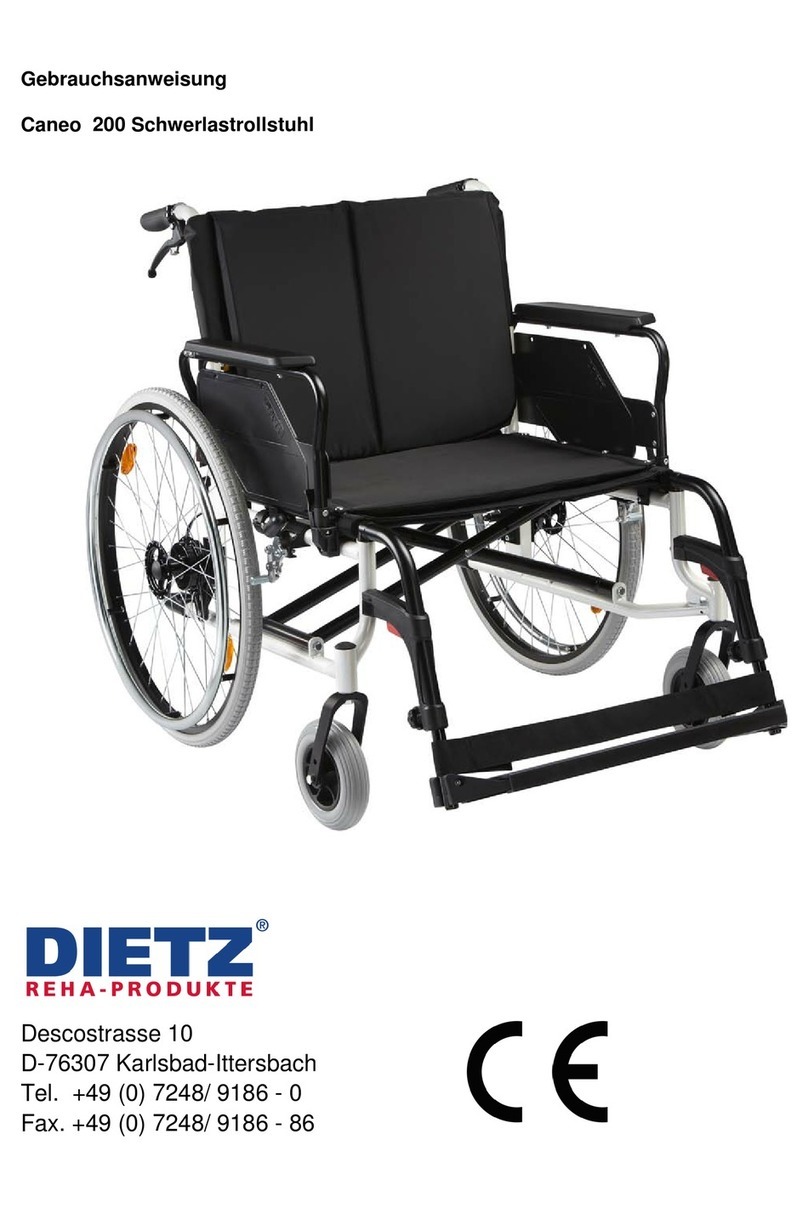
Dietz
Dietz Caneo 200 User manual

Dietz
Dietz MINKO User manual
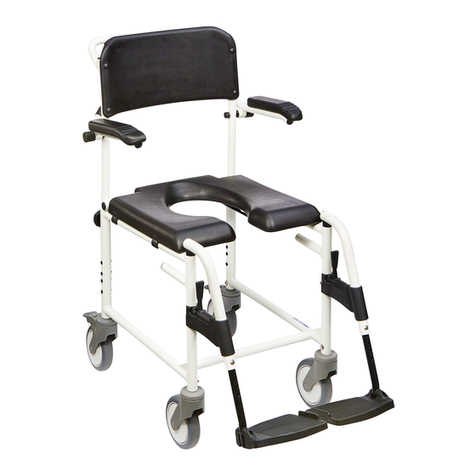
Dietz
Dietz TOMTAR Levina 320-2 User manual
![Dietz AS[01] User manual Dietz AS[01] User manual](/data/manuals/20/j/20jko/sources/dietz-as-01--manual.jpg)
Dietz
Dietz AS[01] User manual
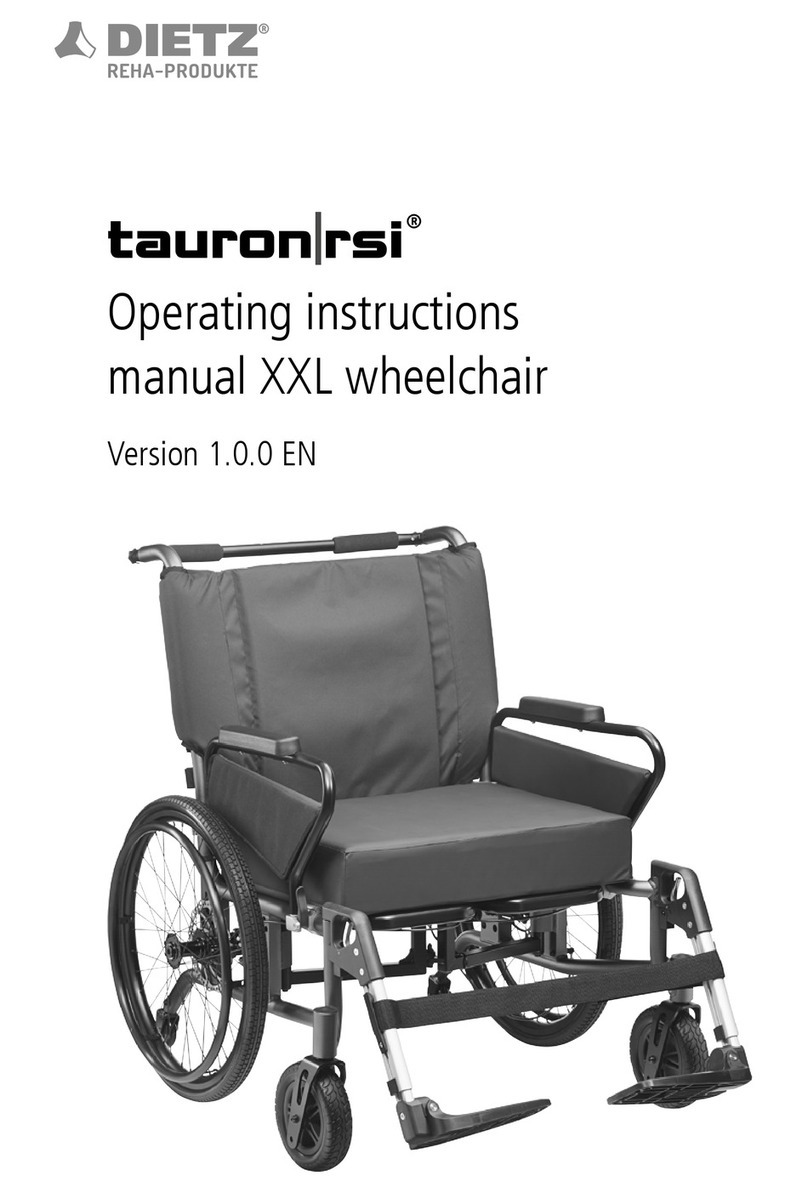
Dietz
Dietz tauron rsi XXL User manual
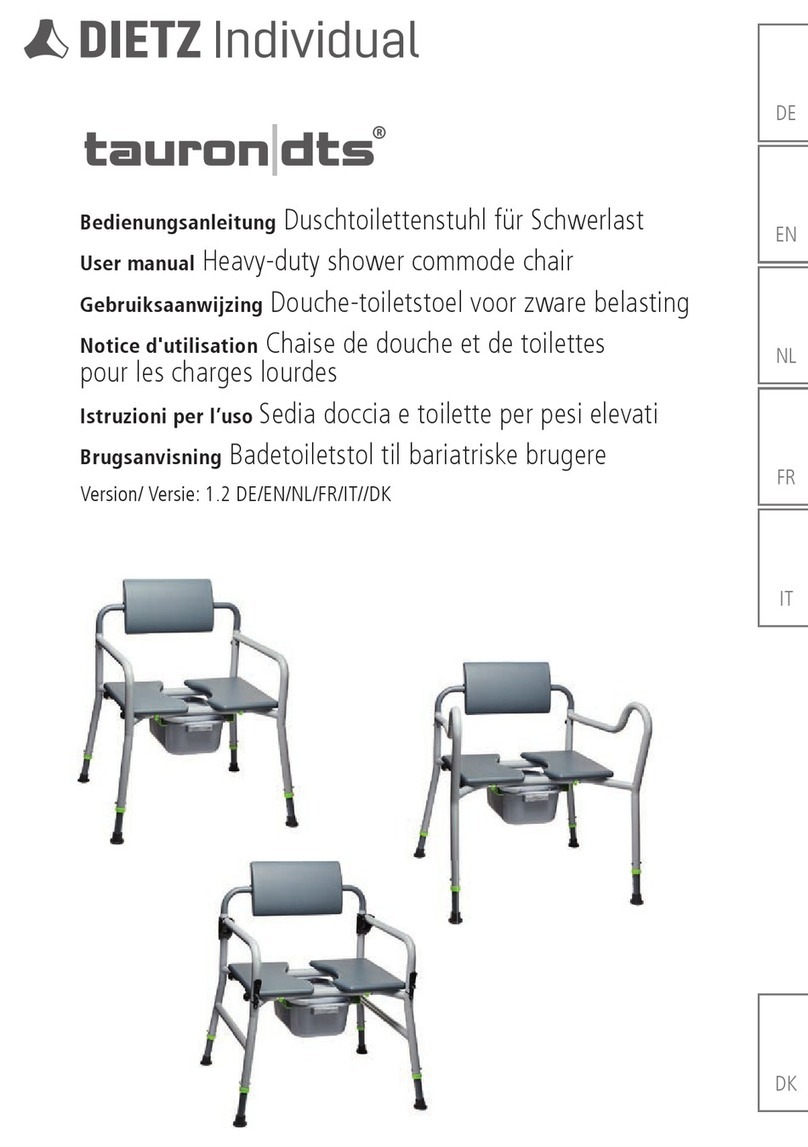
Dietz
Dietz Tauron User manual
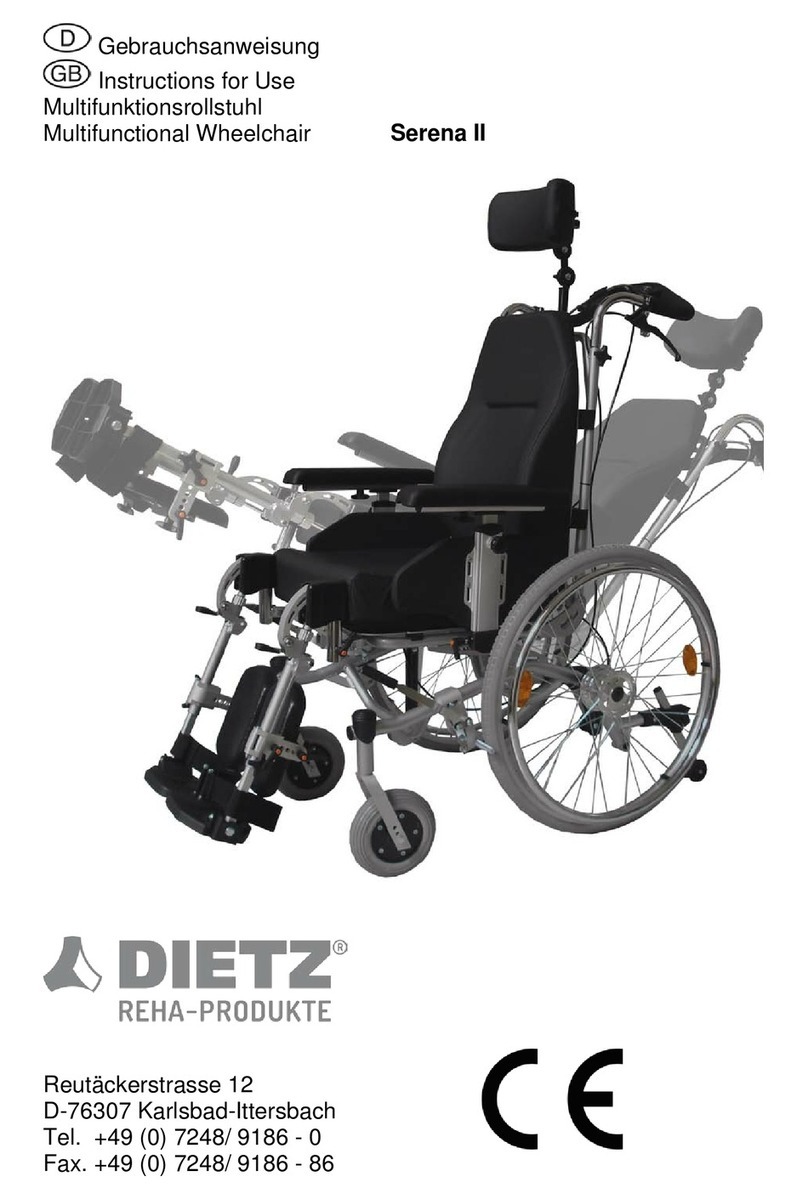
Dietz
Dietz Serena II User manual

Dietz
Dietz TOMTAR Bano User manual
![Dietz AS[01] User manual Dietz AS[01] User manual](/data/manuals/1u/i/1ui1k/sources/dietz-as-01--manual.jpg)
Dietz
Dietz AS[01] User manual

Dietz
Dietz SANGO ADVANCED Series User manual
